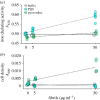Functional amyloids promote retention of public goods in bacteria
- PMID: 31138071
- PMCID: PMC6545082
- DOI: 10.1098/rspb.2019.0709
Functional amyloids promote retention of public goods in bacteria
Abstract
The growth and virulence of bacteria depends upon a number of factors that are secreted into the environment. These factors can diffuse away from the producing cells, to be either lost or used by cells that do not produce them (cheats). Mechanisms that act to reduce the loss of secreted factors through diffusion are expected to be favoured. One such mechanism may be the production of Fap fibrils, needle-like fibres on the cell surface observed in P. aeruginosa, which can transiently bind several secreted metabolites produced by cells. We test whether Fap fibrils help retain a secreted factor, the iron-scavenging molecule pyoverdine, and hence reduce the potential for exploitation by non-producing, cheating cells. We found that: (i) wild-type cells retain more iron-chelating metabolites than fibril non-producers; (ii) purified Fap fibrils can prevent the loss of the iron-chelators PQS ( Pseudomonas quinolone signal) and pyoverdine; and (iii) pyoverdine non-producers have higher fitness in competition with fibril non-producers than with wild-type cells. Our results suggest that by limiting the loss of a costly public good, Fap fibrils may play an important role in stabilizing cooperative production of secreted factors.
Keywords: Pseudomonas; cooperation; functional amyloid; pyoverdine; social evolution.
Conflict of interest statement
We declare we have no competing interests.
Figures




Similar articles
-
Environmental modification via a quorum sensing molecule influences the social landscape of siderophore production.Proc Biol Sci. 2017 Apr 12;284(1852):20170200. doi: 10.1098/rspb.2017.0200. Proc Biol Sci. 2017. PMID: 28404780 Free PMC article.
-
The effect of cheats on siderophore diversity in Pseudomonas aeruginosa.J Evol Biol. 2018 Sep;31(9):1330-1339. doi: 10.1111/jeb.13307. Epub 2018 Jul 2. J Evol Biol. 2018. PMID: 29904987 Free PMC article.
-
Evolutionary dynamics of interlinked public goods traits: an experimental study of siderophore production in Pseudomonas aeruginosa.J Evol Biol. 2015 Jan;28(1):29-39. doi: 10.1111/jeb.12559. Epub 2015 Jan 6. J Evol Biol. 2015. PMID: 25421271
-
Pyoverdine siderophores: from biogenesis to biosignificance.Trends Microbiol. 2007 Jan;15(1):22-30. doi: 10.1016/j.tim.2006.11.004. Epub 2006 Nov 21. Trends Microbiol. 2007. PMID: 17118662 Review.
-
Metal trafficking via siderophores in Gram-negative bacteria: specificities and characteristics of the pyoverdine pathway.J Inorg Biochem. 2008 May-Jun;102(5-6):1159-69. doi: 10.1016/j.jinorgbio.2007.11.017. Epub 2007 Dec 14. J Inorg Biochem. 2008. PMID: 18221784 Review.
Cited by
-
SOCfinder: a genomic tool for identifying social genes in bacteria.Microb Genom. 2023 Dec;9(12):001171. doi: 10.1099/mgen.0.001171. Microb Genom. 2023. PMID: 38117204 Free PMC article.
-
Computational Assessment of Bacterial Protein Structures Indicates a Selection Against Aggregation.Cells. 2019 Aug 8;8(8):856. doi: 10.3390/cells8080856. Cells. 2019. PMID: 31398930 Free PMC article.
-
Complex extracellular biology drives surface competition during colony expansion in Bacillus subtilis.ISME J. 2022 Oct;16(10):2320-2328. doi: 10.1038/s41396-022-01279-8. Epub 2022 Jul 5. ISME J. 2022. PMID: 35790818 Free PMC article.
-
How public can public goods be? Environmental context shapes the evolutionary ecology of partially private goods.PLoS Comput Biol. 2022 Nov 1;18(11):e1010666. doi: 10.1371/journal.pcbi.1010666. eCollection 2022 Nov. PLoS Comput Biol. 2022. PMID: 36318525 Free PMC article.
-
Ten recent insights for our understanding of cooperation.Nat Ecol Evol. 2021 Apr;5(4):419-430. doi: 10.1038/s41559-020-01384-x. Epub 2021 Jan 28. Nat Ecol Evol. 2021. PMID: 33510431 Free PMC article. Review.
References
Publication types
MeSH terms
Substances
Associated data
LinkOut - more resources
Full Text Sources
Other Literature Sources
Medical
Miscellaneous

